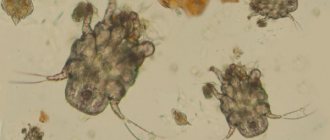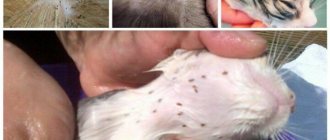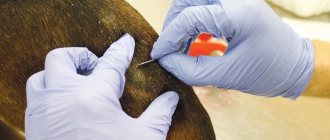Ear mites in kittens and adult cats are not so rare. In the absence of timely, qualified treatment, a pet can not only lose hearing, but also die. That's why it's important to keep an eye on your animal: if your cat is shaking its head and scratching its ears, it's time to check it for ticks.
What are ear mites and how to recognize them?
Among the diseases of pets, including cats, the most common is otodectosis or ear mites. These are small parasites that are localized in the ear canals of animals. They feed mainly on lymph, blood and particles of the epidermis. You can see mites in your cat's ears. These parasites have an oval body, dark in color. Its length is 0.5 mm.
The active activity of ticks leads to injuries to the external and internal auditory canals. As a result of parasites injuring the skin until it bleeds, cats begin to develop ear scabies or otodectosis. This is a dangerous bacterial infection, the advanced form of which can result in the death of your pet. Most often, otodectosis affects kittens, although adults are also susceptible to this infection. This disease does not pose any threat to humans.
How to treat the ears
You need to treat the ears of your furry pet as follows.
- Before using the medicine, the cat's ears are cleaned of accumulated plaque. This will allow the medicine to penetrate deeper. For cleansing, use special solutions or regular vegetable oil. The surface of the ear is wiped with a cotton pad or a piece of bandage soaked in the solution. Hydrogen peroxide or other agents should not be instilled into the ear canal!
- Apply ointment or drops to the clean surface of the auricle in the amount specified in the instructions for the drug.
- To ensure that the medicine is distributed evenly, the ear needs to be massaged a little.
- If drops are used, the cat's head should be supported to prevent shaking and the medicine being thrown out.
- In conclusion, it is recommended to wipe the auricle again with a cotton pad soaked in the same product.
Attention: it is not recommended to use cotton swabs to treat the ears of an animal - the likelihood of injury to the ear canal and infection in the deep parts of the ear increases.
Routes of infection
There are several options for an animal to become infected with a parasite, and one of the most possible is for the animal to regularly stay outside. Unsafe parasites can lie in wait for him anywhere - in basements, grass, in the attic. In addition to ear mites, cats can contract other equally dangerous diseases.
A pet often becomes a victim of parasites after contact with a sick animal or through common care items:
- combs;
- portable container, etc.
Often, a cat becomes infected with a tick while constantly staying at home. The reason for this phenomenon is the owners themselves when they bring parasites into the house on their clothes, shoes or hands.
The culprits of infection are often flies or fleas. The most favorable period for infection is the warm season.
What are the most effective remedies for ticks: drops, ointments or folk remedy therapy?
Finding a cure for ticks will not be particularly difficult.
To do this, you can use drops, ointments, folk remedies:
- drops on sale. You can choose a medicine for kittens, pregnant cats or elderly animals. One of the advantages of drops is ease of use.
- Ointments are the main medicine. Their range is not so wide, but they last much longer, which prevents the further spread of the mite deep into the ear. The disadvantage of ointments is that they are difficult to apply.
- Folk remedies . It is easy to prepare medications at home, but experts insist that it will not be possible to eradicate the parasite using folk remedies; it will only waste time. The best you can hope for is a reduction in the insect population.
At the initial stage of infection, it is recommended to use drops, and at an advanced stage, additional ointments should be used. Folk remedies are suitable for preventing infection during dangerous periods of the year.
Signs
The following symptoms will help you recognize the presence of the disease and quickly begin to fight parasites:
- the cat’s behavior changes - due to constant itching, the animal becomes anxious, even aggressive;
- the cat regularly shakes its head and scratches its ears;
- redness and peeling appear on the inner surface of the ears;
- liquid discharge appears from the ears, which, when hardened, turns into brown scabs;
- unpleasant odor from the ears due to accumulating pus;
- swelling is visible in the sore ear;
- The cat stops eating.
Such symptoms should be a cause for alarm and prompt contact to a specialized specialist, otherwise the tick will penetrate into the pet’s inner ear, which will cause hearing loss or death.
Criteria for choosing ear drops
The veterinary medicine market presents a very wide range of ear drops intended for cats. It's hard not to get lost in such diversity. Therefore, it is important to remember that before making the final choice of tick medications, you need to pay attention to:
- Purpose . It is better to choose narrow-acting products aimed exclusively at combating mites, or inflammation and bacteria. As an active substance, give preference to those that are less toxic.
- State of the animal . Liniment (a product for external use) must be selected taking into account the patient’s health. Many substances cannot be used if the cat is weakened, nursing or pregnant.
- Degree of disease . At the very beginning of infection, it is necessary to use solutions with a gentle composition, leaving aggressive ones for difficult cases.
The best ear drops
The animal is treated with drugs available in a wide range of veterinary pharmacies. Their choice should be treated carefully, because... Some remedies do not help, others have a temporary effect, and others cause adverse reactions and only complicate treatment.
It is important to consider the age of the animal and its condition. For example, there are drops that are suitable only for adult animals. Other drugs are not suitable for pregnant and lactating cats.
It is important to read in detail the instructions that come with the product. The drops are not harmless and if they are used incorrectly or the correct dosage is not followed, animals can be seriously harmed, especially kittens.
Anandin plus
These drops have no side effects and are inexpensive. A bottle of this product will cost the buyer 50 rubles. It contains active substances:
- decamethoxin;
- amitrazine
The drug not only fights the parasite, but also counteracts fungal and infectious diseases. Its components eliminate:
- irritation;
- itching;
- inflammation;
- infections.
If 1 ear is infected, drops must be instilled into both ears 3 times a day. Therapy should last 7 days, after which the doctor examines the sick animal. If necessary, he will recommend taking a repeat course.
This medication has the following properties:
- anti-inflammatory;
- antibacterial.
Positive results are obvious immediately after the first use of the drug. The product is non-toxic and does not cause any allergic reactions.
Otoferonol gold
This is another effective veterinary drug. It includes:
- cycloferon;
- propolis;
- pyrethroid deltamethrin;
- alcohol.
Application of drops:
- promotes active tissue restoration;
- has an antimicrobial effect;
- stops the inflammatory process.
The medicine contains a toxic component, so it is prohibited:
- pregnant and lactating females;
- animals up to 2 months old;
- cats with infectious diseases;
- animals with weakened immune systems;
Drops are used once a day for a week. The product stings, but the effect is quick.
Dekta
Complex drug, which includes:
- amitraz;
- levomecithin;
- propolis.
The product has the following properties:
- antimicrobial;
- anti-inflammatory;
- wound healing.
It is instilled into the ears of cats, 2-3 drops per day. The course of treatment lasts a week, after which it is necessary to take a break for 7 days. Treatment is carried out until the parasite is completely eliminated.
It is not recommended to use the drug:
- if the cat is pregnant;
- if the kittens are less than 1 month old.
Ectodes
The drug is acaricidal and includes the following components:
- pyrethroid;
- propolis;
- sulfur;
- dimexide.
The included components have the following actions:
- anti-inflammatory;
- analgesic;
- antiseptic;
- fibrinolytic.
2-3 drops per day are instilled into the ears for a week. The only contraindication for this medication is the animal’s hypersensitivity to its components. The drug is used even in advanced cases, when the stage of otitis media begins.
Leopard
Bars drops are easy to use and safe. Thanks to the correctly selected component of the drug - diazinon - it is possible to quickly cope with the problem and achieve a speedy recovery of the animal. Its advantages:
- Does not cause allergies.
- Has antiseptic and anti-inflammatory properties.
- Actively fights pathogens.
- Helps eliminate swelling and itching in a short time.
Already on the 2nd day of using the drops, you can see an improvement in the animal’s condition. In order not to reduce the effectiveness of the product, the procedure schedule must be strictly followed. The use of the product should be stopped immediately if the cat develops the following signs:
- itching;
- redness;
- vomit.
Demos
You can also treat hearing aids with medications in cats using Demos. Its auxiliary components:
- reduce inflammation;
- have an active acaricidal effect;
- promote rapid healing of damaged areas;
- have a detrimental effect on pathogens.
The ears of a sick animal are treated with the product 2-3 times a day. The course of treatment is 7 days. The break should be at least 5-7 days, after which the therapy procedures are repeated until the pet recovers completely.
Mycodemocid
This drug is not the least effective among anti-tick drugs for cats. Apply it 1 time. The animal's ears are treated with the product (1-2 drops), after which they need to be massaged. At an advanced stage of the disease, the action must be repeated after 5 days.
The main component is sea buckthorn oil, under the influence of which parasites die. The drug is non-toxic and safe.
Due to the use of the product:
- trophic processes in tissues improve;
- damaged areas are quickly regenerated;
- the coat is restored;
- the general condition of the animal improves;
- the pet's appetite returns;
- immunity is restored.
Treatment
To treat otodectosis in cats and cats, preparations for external use are used that destroy ear mites. They have antiparasitic, antifungal, antimicrobial and anti-inflammatory effects.
Before applying these products, the ears are thoroughly cleaned: scabs, exudate, accumulations of wax and waste products of parasites are removed from them. For this purpose, you can use a 3% solution of hydrogen peroxide, lotions “Bars”, “Otomin”, spray “Auricap”. It is better to wipe the pinna and ear canal with a cosmetic disc; a cotton swab can damage the eardrum if moved carelessly.
To treat a cat for ear mites, there are various forms of insecticidal and acaricidal medications.
Drops
- Amitrazine.
Active ingredients: cypermethrin and amitraz. , Russia. - Surolan.
Active ingredients: miconazole, polymyxin sulfate, prednisolone. , Belgium. - Aurikan.
Ingredients: diazinon, prednisolone, hexamidine, tetracaine hydrochloride. Manufacturer: Agrovetzashchita, Russia. - Dekta-Forte.
Active ingredients: amitraz, chloramphenicol. Manufacturer: Apicenna, Russia. - Leopard.
Active ingredient: diazinon, Russia.
These liquid preparations are instilled into the cleaned ear canal using a pipette, then lightly massage the ear to better distribute the product over the surface of the skin.
Treatment of otodectosis in cats: video
Ointments or gels
- Aversectin ointment
(“Farmbiomedservice”, Russia). Active ingredient: aversectin. - Novertine ointment
(“Ukrzoovetprompostach”, Ukraine). Active ingredient: aversectin. - Ordermil
(Vetoquinol, France). Ingredients: neomycin, nystatin, lindane, triamcinolone acetonide, lidocaine.
Ointments and gels are applied in a thin layer to the inner surface of the ear, previously cleaned of scabs and crusts.
Aerosols
The most popular of this category of drugs is “Ivermectin spray”, which is produced by the Russian company Vitapharm. It contains dexpanthenol, chlorhexidine bigluconate and lidocaine hydrochloride. The product is sprayed onto the previously cleaned surface of the ears until the affected areas are completely covered.
Drops on the withers
- BlochNet max.
Contains insecto-acaricidal substances fipronil, diethyltoluamide, benzyl benzoate, juvemon. Manufacturer: Astrapharm, Russia. - Bayer Advocate.
Active ingredients: moxidectin and imidacloprid, Germany. - Stronghold.
Made in America based on the parasiticide selamectin. - Fiprist Combo.
The active components are S-methoprene and fipronil, , Slovenia. - Frontline.
The active ingredient is fipronil, a French product. - Unoiled.
The main composition is tetramethrin, transmix. Manufacturer: “Ceva”, France.
Directions for use: Apply the product using a pipette to the animal’s skin in the withers area. To prevent licking of the drug, it is recommended to put a protective collar on the cat for several hours.
The effect of treatment largely depends on strict adherence to the doctor’s instructions. The prescribed course of treatment should not be stopped prematurely, even if the external manifestations of otodectosis have already disappeared - if a few mites remain alive, they will be able to quickly give birth, and the disease will recur.
If a cat develops inflammatory diseases caused by a secondary infection (otitis, abscess), in addition to the main methods of treating otodectosis, the veterinarian may prescribe antimicrobial and anti-inflammatory drugs. To strengthen the immune system, it is recommended to include vitamin and mineral supplements in the animal’s diet.
How to use drops?
In order for the product to work quickly and effectively, you need to use it correctly in compliance with the required doses. Each cat has its own character, so for a productive procedure you must adhere to the following recommendations:
- The pet should be wrapped in a towel so that the head and neck remain exposed. It is necessary to hold the animal tightly so that it does not escape.
- Scabs and crusts formed in the ears should be carefully removed using a cotton swab or cotton swabs, and the neck area should be disinfected.
- Following the recommendations in the instructions, you need to instill the required number of drops into your ears. Since ear mites can move to the body, drops are applied to the animal’s withers and neck. After instilling the product, rub it in with light massaging movements.
- You need to make sure that the cat does not lick itself for a while or use a special collar.
- Care should be taken to ensure that the pet does not come into contact with other pets. They can lick the product from the patient’s fur and become poisoned.
Diagnostics
If you suspect an ear mite infestation, you should immediately contact a specialist. Only he will prescribe the optimal treatment option. Before visiting the veterinarian, the owner can verify for himself whether the animal has a parasite. For this you need a cotton swab and dark material. The stick should be used to clean out as much of the mass present in the pet’s ear as possible. Then it should be tapped over a dark surface in order to shake off the parasite. Having directed a bright light at the material and armed with a magnifying glass, you should observe the extracted secretions for some time. If after about a couple of minutes moving, small yellowish dots become noticeable, it means that your pet is developing otodectosis.
Important nuances
Purchasing medications on your own can lead to disastrous consequences. To establish an accurate diagnosis and prescribe current medications, the animal must be examined by a veterinarian. Also, some drugs cause allergic reactions in cats, manifested by:
- itching;
- hair loss;
- increased temperature;
- rash.
The market offers consumers a wide range of anti-mite medications for kittens to choose from. When purchasing a medicine, you should pay attention to its purpose. You should not buy broad-spectrum products.
The drug must not be toxic.
Contraindications, side effects and precautions
Most anti-ear mite medications have an age limit. Small kittens under 2 months of age should not be treated. It is also not recommended to treat weakened animals with drops.
Possible side effects include the development of an allergic reaction. It is rarely observed, and in this case the pet should be taken to a veterinarian.
Before treating your cat with drops, you must put on medical latex gloves. If the medicine gets on the skin, wash it well with soapy water. Drop containers are disposed of with household waste.
Prevention
If you suspect a pathology in your cat, it is recommended to immediately contact a veterinarian. The disease must be treated; many remedies have been invented to treat ear mites in cats, but it is better to prevent the disease.
Prevention of ear mites involves observing the following rules:
- regular examination of the animal’s ears;
- cleaning your pet's ears as they become dirty;
- prevent cat contact with infectious animals;
- Try to maintain a balanced diet for your cat, providing it with vitamins and essential microelements.
Existing ear mite drops and ointment for cats are an excellent modern solution to the problem. Their timely and correct use will help get rid of the disease faster and improve the condition of your pet.
All information posted on the site is provided in accordance with the User Agreement and is not a direct instruction to action. We strongly recommend that before using any product, you must obtain a face-to-face consultation at an accredited veterinary clinic.
How do you get infected with otodectosis?
Ear mites in cats can appear if the animal has been walking outside and has been in contact with other cats. Most homeless animals suffer from otodectosis. If you let your pet outside, you should carefully examine it after a walk and do not neglect the rules of hygiene.
There is a possibility of introducing ticks on shoes or clothes. The owner can pet an infected feline or simply walk past a pack of stray animals - and this will be enough for the parasite to travel to a completely domestic cat.
There is a high risk of the disease appearing in those homes where similar cases have already occurred. Ear mites in a kitten are transmitted from the mother, as well as through carpets, various products, home furniture - everything that can accumulate dust particles and microorganisms.
Routes of transmission of ticks from one individual to another
The most common variant of infection is contact with already sick animals. It is enough for one cat to sniff another for several parasites to leave the host and be transmitted to a healthy animal. But there are also indirect methods of infection.
Cat ear mites live up to two months in their natural environment, which means they can be picked up through indirect contact. The disease is transmitted through care products: scratchers, carriers, bedding. Sometimes the infection is carried by fleas or flies.
If a room is not regularly cleaned, the mite settles there, waiting for a host. This should be taken into account when moving or when leaving a cat as a guest for a while.
At elevated temperatures the parasite lives even longer. It stays on clothing and shoes. Therefore, it is important to protect your cats from contact with outdoor shoes and outerwear - ideally, there should be a closed closet in the apartment.
To summarize, we can say that the main “helper” of otodectosis infection is unsanitary conditions. A domestic cat that is carefully cared for, vaccinated and kept clean has the least chance of getting sick.
Progression of the disease in stages
Otodectosis is the most popular skin disease. Ear mites in cats are diagnosed in 85% of cases when breeders treat suspected otitis media. The carpet beetle corrodes the upper surfaces of the epidermis, located on the inside of the shell. The disease proceeds as follows:
- Mechanical injury. At this point, the upper layers of the dermis are damaged. With its powerful mouthparts, the parasite chews the surface, obtaining blood and lymph. The nerve endings become irritated, resulting in severe itching.
- Blood vessels begin to thin out. They become filled with blood, redness and swelling appear.
- You may notice persistent discharge in areas of damaged skin.
- Dark brown scabs form from dead skin cells, as well as other waste products of pests. The whole process is accompanied by the formation of putrefactive microflora.
- There is a gradual accumulation of scabs and crusts, which leads to the formation of a plug. Hearing begins to become dull. If measures are not taken, the eardrum will rupture. The infection opens up to the middle and inner ear.
If parasitosis is advanced, then an active inflammatory process develops in the inner and middle ear. The symptom is a certain behavior of the animal: the sick person walks with his head turned 90 or even 120 degrees. The ear that hurts will point downwards. This process leads to the spread of pathology to the membranes of the brain, sepsis and, as a result, death.
Breeders need to remember that such a simple disease can result in disastrous consequences. But even in advanced cases, it is possible to successfully treat ear mites in a cat and avoid serious consequences.











